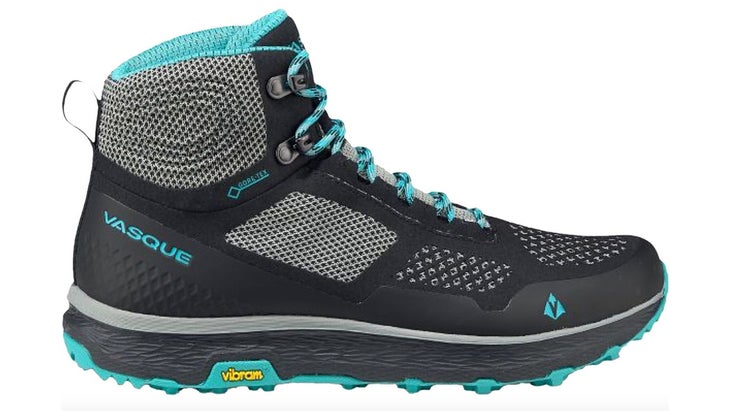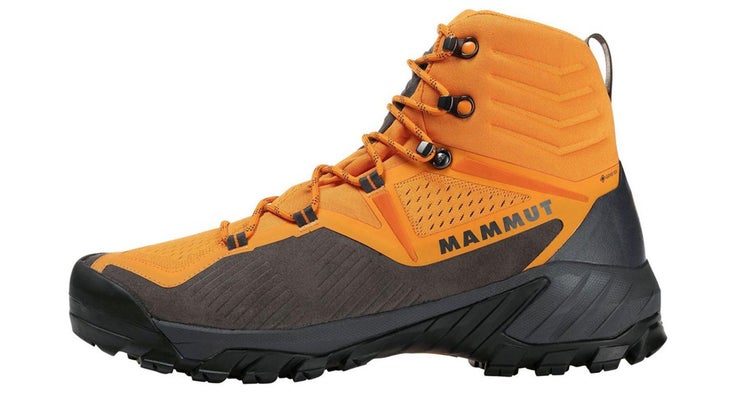Products You May Like
Backpacking trips come in many shapes and sizes. A hike can look like anything from a quick overnight with a light pack to a multiday trek under a heavy load. And just as no two trips are alike, no two hiking boots are alike—even if they look similar on the outside. The Mammut Sapuen High GTX and the Vasque Breeze LT GTX are both top-notch boots. But while they may seem outwardly similar—each has a slightly narrower, more nimble last than a traditional boot, a mid-cut ankle cuff, a robust midsole, a synthetic upper, and weighs less than 2 pounds per pair—they’re best-suited for different niches of hikers, hikes and terrain. We put them up against each other so you can decide which is right for you.

Vasque Breeze LT GTX
The Breeze LT GTX ($180) is the latest entry in Vasque’s storied Breeze line, known for out-of-the-box comfort and versatility. Where the LT sets itself apart from its predecessors is in its lightweight, nimble trail feel. While it’s slightly heavier than the Sapuen (a pair comes in at 1 lb. 11 oz.), the Breeze LT strides more like a trail running shoe than a mid-cut hiking boot. Made mostly of microfiber and mesh, it’s also breathable (even with a waterproof/breathable Gore-Tex membrane). On the Sawtooth, a ridge that connects Colorado Fourteeners Mt. Bierstadt and Mt. Evans, this boot felt agile and and secure (thanks to a Vibram Megagrip outsole) even when traversing scrambly, exposed third-class terrain. During a 30-mile backpacking trip in the Indian Peaks Wilderness, the soft EVA midsole had no issue with a 40-pound pack. The caveat: This trail wasn’t nearly as rugged as the Sawtooth, which required only a daypack.
Dayhikes and short overnights are where the Breeze LT truly shines. It can handle a heavier load on easier trails, and especially on hot days, you’ll never want to sacrifice the Breeze LT’s, well, breeziness. Those spending a lot of time in the desert or warmer climates should consider it for it’s breathability alone. But with more weight or on a trail where ankle support becomes more important, it might let you down. Their only other ding (not a major surprise for the Breeze line, either) is the LT’s durability: The rubber rand as well as the mesh became unglued in spots after a season of use.

Mammut Sapuen High GTX
Look closely from the outside and you can already start to see some of the ways the Sapuen High GTX ($189) differentiates itself from the Breeze LT. Its beefy over-the-toe rand stands up to rough treatment on the trail, as does the thicker Vibram outsole and firmer EVA midsole. The Sapuen’s upper also contains more leather and less mesh. The result is a boot that can handle bigger loads in sketchier terrain, keep your ankle in place, and not wear down your joints. Our primary testing ground for the Sapuen was Montana’s East Rosebud Trail, a rugged and rocky route through the Beartooth Mountains. The boots were light on our tester’s feet (1 lb. 3 oz.) but easily handled a 45-pound pack along loose sidehills above lakes, precarious routes around waterfalls, and more. What you can’t see is the corrugated sheet of steel which serves as both a rock plate and a shank, keeping the boot from twisting without sacrificing flex. The leather upper required a very brief break-in to loosen up but made our testers feel a little more confident that they weren’t going to twist an ankle in less straight-forward terrain. And a (relatively) small mesh panel did a surprisingly good job of dumping heat on warmer days.
The Sapuen is a true do-it-all backpacking boot, boasting great support with a surprisingly low weight and high comfort. But where the boots really shine is when you need load-carrying capability on more technical terrain.
